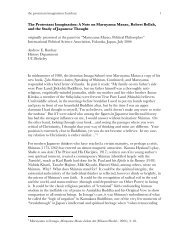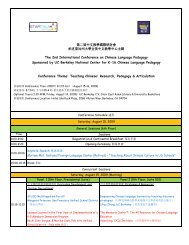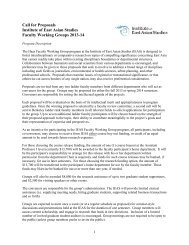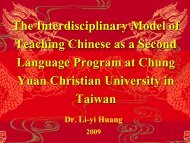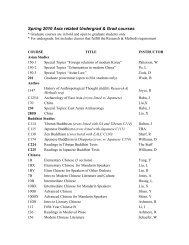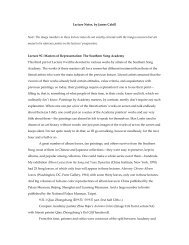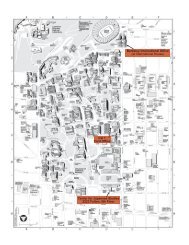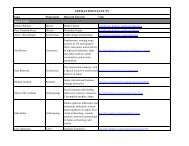Third Edition Spring 2013 - Institute of East Asian Studies, UC ...
Third Edition Spring 2013 - Institute of East Asian Studies, UC ...
Third Edition Spring 2013 - Institute of East Asian Studies, UC ...
Create successful ePaper yourself
Turn your PDF publications into a flip-book with our unique Google optimized e-Paper software.
dence leaders, most notably India’s first prime minister, JawaharlalNehru. As the German political scientist Michael Liebig pointed outin a recent presentation, one view “contends that the Indian independencemovement needed Kautilya vis-à-vis the colonial powerin order to demonstrate that the ancient Arthashastra was at parwith, or even superior to, the ancient and medieval works <strong>of</strong> Europeanpolitical theory, for example, Machiavelli’s The Prince.” 27 Thediscovery <strong>of</strong> indigenous political and economic ideas dating backto the third century BCE—long before Western scholars wouldindependently develop similar ideas—became a great source <strong>of</strong>pride for Indians. As Liebig stated in his presentation, Kautilya is“present in the Indian public mind as a ‘metaphor’” for “(1) thecunning politician getting the job done, and (2) the historical personalitywho unifies India.” 28 Thus, Kautilya is part <strong>of</strong> the “broadspectrum <strong>of</strong> Indian politico-cultural icons” 29 consisting <strong>of</strong> such figuresas “Buddha, Asoka, Akbar, Aurobindo, Gandhi, and Nehru,” 30who helped unify, metaphorically or literally, India.As Liebig demonstrated, Kautilya’s importance to the Indiannationalists <strong>of</strong> the 20th century lay in his iconicity and in theArthashastra’s incredible political and economic ideas. This is notthe entire extent <strong>of</strong> Kautilya’s significance to the nationalist movement,however, as the nationalists were also drawn to his idea <strong>of</strong>a pan-Indian state. As mentioned earlier, the Mauryan Empire thatKautilya and Chandragupta built was the first state to span the Indiansubcontinent. Kautilya himself writes <strong>of</strong> his desires for the kingto be a world conqueror, stating that only after “Having conqueredthe earth with its people <strong>of</strong> distinct castes and divisions <strong>of</strong> religiouslife, should [the king] enjoy it by governing it in accordance withthe duties prescribed to kings.” 31 Thus, the Arthashastra’s legendaryauthor believed that the ideal king would be a world conqueror.While world conquest and the creation <strong>of</strong> a pan-Indian statemay appear to be entirely different ideas, Roger Boesche claims27 Gautam, P.K. Endogenous Politico-Cultural Resources: Kautilya’s Arthashastraand India’s Strategic Culture28 Ibid.29 Ibid.30 Ibid.31 Kautilya. Arthashastra. Translated by R. Shamasastry. Bangalore: GovernmentPress, 1915, 475-493that the two are in fact synonymous. Boesche claims that “Kautilyaapparently meant by the phrase ‘conquering the world’ somethinglike conquering up to what Indians regarded as the natural borders<strong>of</strong> India, from the Himalayas all the way south to the IndianOcean, and from the Arabian Sea to the Bay <strong>of</strong> Bengal.” 32 In fact,Kautilya mentions in Book IX <strong>of</strong> the Arthashastra that “Country(space) means the earth; in it the thousand yojanas <strong>of</strong> the northernportion <strong>of</strong> the country that stretches between the Himalayasand the ocean form the dominion <strong>of</strong> no insignificant emperor.” Thisregion described as the “world” simply refers to the extent <strong>of</strong> theIndian subcontinent, bound in the north by the Himalayas and inthe south, east, and west by water. Therefore, Kautilya believes thata true world conqueror needs only control the region <strong>of</strong> India, asopposed the entire world.This makes Kautilya one <strong>of</strong> the earliest—if not the earliest—proponents<strong>of</strong> a pan-Indian state. This was <strong>of</strong> particular importanceto the Indian nationalists, who were fighting to establishan Indian-controlled state spanning the entire subcontinent. Thenationalists saw the Arthashastra as a potential source <strong>of</strong> historicalsupport for their idea <strong>of</strong> a single Indian nation. Kautilya and theArthashastra were, thus, significant to the Indian nationalists forthree reasons: (1) the legendary Kautilya’s iconicity; (2) the Arthashastra’spolitical and economic ideas, which preceded its Westerncounterparts; and (3) the Arthashastra’s envisioning <strong>of</strong> a singlestate spanning the Indian subcontinent.Although Kautilya and the Arthashastra were important tothe Indian nationalist movement, their significance faded immediatelyafter India and Pakistan gained independence. However,Kautilya’s importance as an icon is once again on the rise. MichaelLiebig believes that Kautilya and his fellow Indian politico-culturalicons have the potential to have a huge impact on the modernworld, provided India can promote its diverse, yet cohesive culturalresources in a manner similar to China’s promotion <strong>of</strong> Confucianism.33 This means that India can make Kautilyan thought as well32 Roger Boesche, “Kautilya’s Arthashastra on War and Diplomacy in AncientIndia,” The Journal <strong>of</strong> Military History, 67, no. 1 (2003): 9-37.33 Gautam, P.K. Endogenous Politico-Cultural Resources: Kautilya’s Arthashastraand India’s Strategic Culture65 Ramanathan Veerappan Kautilya’s Arthashastra 66




